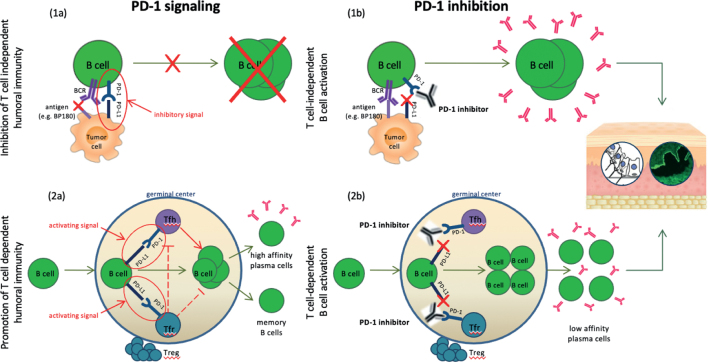Fig. 2.
Suggested pathogenesis of anti-programmed cell death protein 1 (PD-1)/programmed cell death ligand 1 (PD-L1) associated bullous pemphigoid (BP) involving both B- and T-cell dysregulation. (1a) PD-1 signalling in T-cell-independent humoral immunity: PD-1 signalling inhibits the binding of the tumour antigen (e.g. BP180) to its receptor on B cells (BCR), suppressing further B cell expansion. (1b) T cell independent B cell activation after PD-1 inhibition: PD-1 blockade enhances the BCR response and initiates B cell expansion with subsequent antibody production, responsible for a cross-reactive immunogenicity against the basal membrane of the skin. (2a) PD-1 signalling in the T-cell-dependent humoral immunity: PD-1 signalling acts as a promoter in T-cell-dependent humoral immunity for both follicular helper T (Tfh)-B cell and follicular regulatory T (Tfr)-B cell interaction within the germinal centres. Tfh cells mediate the selection and survival of B cells, enabling their differentiation into either high-affinity antibody-producing plasma cells or memory B cells. On the other hand, Tfr cells suppress both Tfh cells and B cells and thus control unwarranted germinal centre reactions. (2b) T-cell-dependent B cell activation after PD-1 inhibition: PD-1 inhibition negatively impacts both the selection of potentially mutated B cells by Tfh cells and the inhibitory function of Tfr, enhancing an aberrant production of low-affinity plasma cells, that can drive antibody-mediated autoimmune phenomena, including BP. Treg: regulatory T cell.

